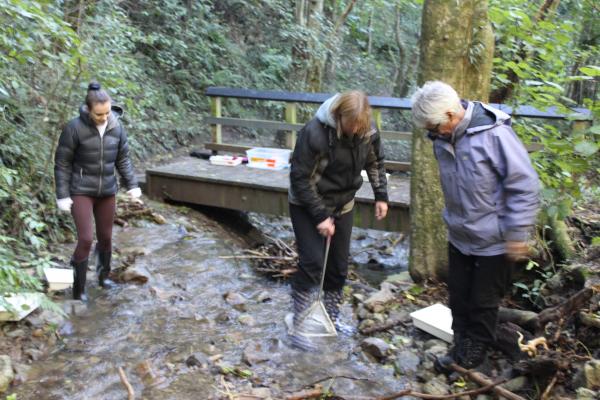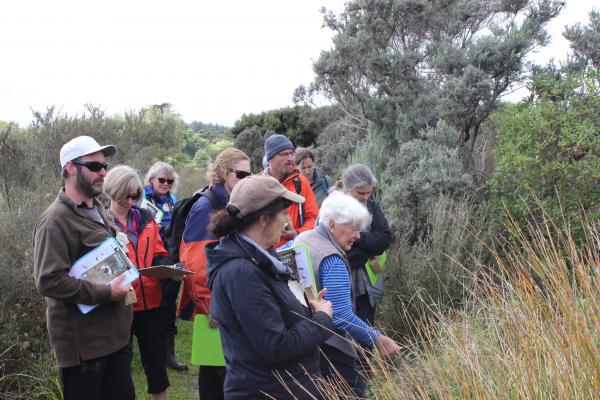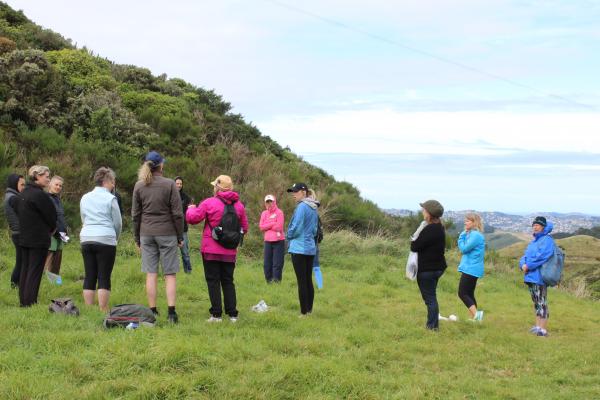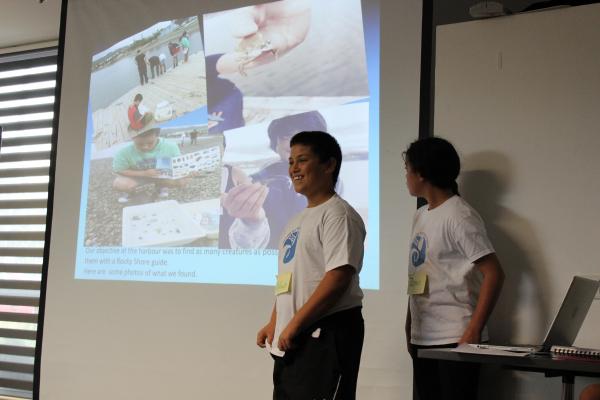Porirua Harbour Trust

Teacher Professional Learning
The Porirua Harbour Trust’s education programme up until the departure of our Education Coordinator in mid 2021 included regular professional learning opportunities for teachers in the catchment area.
CLICK HERE to read the Education Gazette article (Aug 2018) about our ‘Nature is our Classroom’ teacher PLD.:
PAST PLD EVENTS:October 31st, 2018: NATURE IS OUR CLASSROOM – Paparangi
This full day workshop was available to all ECE, primary and secondary schools in the following areas of the catchment: Newlands, Johnsonville, Paparangi and Churton Park. We spent the day exploring the local environment in Seton Nossiter Park (Paparangi), and were joined by a range of local experts.
July 2018: NATURE IS OUR CLASSROOM – Rangituhi (Stage 2 workshop)
Teachers who have already taken part in our ‘Nature is our Classroom’ PLD spent the day exploring and deepening their knowledge and experience in the bush at Rangituhi. We were joined by educators and scientists from DOC, Greater Wellington Regional Council, and Sustainable Coastlines, and teachers were able to choose areas of interest to engage with (stream monitoring, marine metre squared, seed balls, leaf litter biomes, DOC education resources etc).

March 2018: Marine Metre Squared Teacher Workshop
Teachers from around the catchment joined Sally Carson, from the University of Otago, to learn about the Marine Metre Squared project. It is a great tool that can be accessed by anyone in the community, and enables people to explore and discover plants and animals found on their local shore (sandy, muddy or rocky shores). The data can then be uploaded and shared with others, as part of a larger “citizen science” platform. To find out more go to the Marine Metre Squared website
This workshop was funded by DOC and supported by Enviroschools, Porirua Harbour Trust, and Mountains to Sea Wellington.

March 2018 : NATURE IS OUR CLASSROOM – Rangituhi/Elsdon
A day of exploration for kaiako in the Te Awarua-o-Porirua Harbour catchment. We spent most of the day outside, in the beautiful native bush on Rangituhi/Colonial Knob, based at Camp Elsdon. This valley contains one of the catchment streams for Te Awarua o Porirua and we reflected on the effects that human settlement have had on the health of our waterways and biodiversity of our forests. Using experiential learning, we explored ways to learn in the outdoors, exploring science, social science, arts, numeracy and literacy, in an engaging and relaxing environment.
CLICK HERE to access the Padlet- it contains all of the relevant links from this PLD, including websites, teaching resources, suggested reading, videos and much more. It is open to the public, so all teachers and community members are welcome to view and use the site.

October 2017: NATURE IS OUR CLASSROOM – Pāuatahanui Inlet
A day of exploration for kaiako in the Te Awarua-o-Porirua Harbour catchment. We spent most of the day outside, in the Pāuatahanui Wildlife Reserve and at Motukaraka Point. Using experiential learning, we explored ways to learn in the outdoors, exploring science, social science, arts, numeracy and literacy, in an engaging and relaxing environment.
CLICK HERE to access the Padlet- it contains all of the relevant links from this PLD, including websites, teaching resources, suggested reading, videos and much more. It is open to the public, so all teachers and community members are welcome to view and use the site.

March 2017 : NATURE IS OUR CLASSROOM – Rangituhi/Elsdon
A day of exploration for kaiako in the Te Awarua-o-Porirua Harbour catchment. We spent most of the day outside, in the beautiful native bush on Rangituhi/Colonial Knob, based at Camp Elsdon. This valley contains one of the catchment streams for Te Awarua o Porirua and we reflected on the effects that human settlement have had on the health of our waterways and biodiversity of our forests. Using experiential learning, we explored ways to learn in the outdoors, exploring science, social science, arts, numeracy and literacy, in an engaging and relaxing environment.
CLICK HERE to access the Padlet- it contains all of the relevant links from this PLD, including websites, teaching resources, suggested reading, videos and much more. It is open to the public, so all teachers and community members are welcome to view and use the site.

June 2016: NURTURING KAITIAKITANGA
Empowering our students to create a sustainable future, through authentic environmental action projects. Guiding questions for the day:
- Why is environmental education so relevant and engaging?
- How can I gain the confidence to facilitate student-directed projects?
- What sort of resources and support are available to schools?
- What are other local schools doing and can we work together?
The guest speakers were teachers and students from Porirua primary and secondary schools, who shared their environmental action experiences. Representatives from a range of organisations (PCC, Healthy Harbours Porirua, Partners Porirua, School garden/compost educator) were also present, to network with teachers and talk about the support they can offer schools. This workshop was facilitated by Porirua Harbour Trust and Enviroschools, with funding from the Philipp Family Foundation.
CLICK HERE to access the Padlet- it contains all of the relevant links from this PLD, including websites, teaching resources, suggested reading, videos and much more. It is open to the public, so all teachers and community members are welcome to view and use the site.

March 2016: DOWN THE DRAIN – Exploring Stormwater in the Catchment (Sci, SS and Art)
We explored the stormwater system in the catchment – how it works and how it affects the health of our harbour? The morning included guest speakers from Te Runanga o Toa Rangatira, Wellington Water Ltd, and the local and regional councils. We also explored the resources and support available for schools who were learning about the harbour and catchment. The afternoon waa spent with the fabulous Pataka educators, who guided us through a hands-on art experience to demonstrate how students could create drain art for their school. Facilitators: Enviroschools and the Porirua Harbour Trust, with funding from the Greater Wellington Regional Council and the Philipp Family Foundation.

Feb 2016: PAUATAHANUI WILDLIFE RESERVE – Teacher Open Day
We explored this amazing natural resource and chatted with one of the founding members, Wanda Tate. We explored the reserve and talked about tips for planning field trips, links to the NZC and the range of education resources available to support teachers.
To access resources about the reserve, CLICK HERE to visit the Naturespace page.
August 2015 – Te Awarua-o-Porirua Harbour: PROTECTING OUR TAONGA (focus on SS/History)
We explored the history of Te Awarua-o-Porirua Harbour, and how humans have affected this precious taonga. We discussed our role as kaitiaki, and how we can support our students to take ownership of the protection of this unique habitat. Guest speakers from Pataka, PCC and Te Runanga o Toa Rangatira guided us through the rich history of this area, and highlighted the key impacts that modern human developments have had on the ecosystems and mana whenua.
June 2015 – Teacher Afternoon Tea and PLD (Matariki focus)
This session was run by the Trust’s Education Coordinator (Rebecca McCormack) and the Enviroschools facilitator for Porirua (Arihia). As this session fell during Matariki, we looked at how teachers could incorporate Maori perspectives into their teaching. We also demonstrated how the newly produced catchment map could be used to help provide students with an overview of their learning about the harbour and catchment (ecology, local iwi/history, human impact, field trips etc). Afternoon tea was provided and there was no charge for this workshop.
March 2015 – Teacher Afternoon Tea and PLD (Harbour resources and Student Action)
This session was jointly facilitated by Rebecca (PHT) and Arihia (Enviroschools). We looked at the resources available to help teachers support students with their inquiry and action projects, specifically looking at Porirua Harbour. This will be an informal question/answer session with a few hands-on activities.
November 2014 – Launch of Teacher Education Resource – Introductory workshop and field trip
A full-day workshop for teachers, held at Gear Homestead. The morning was spent exploring the education resources related to the harbour, and discussing how teachers can use these with their students. The afternoon included a field trip component, with visits to Motukaraka Point and Bothamley Park (Kenepuru Stream).








